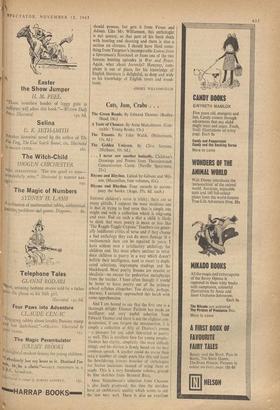Cats, Jam, Crabs . . .
. . . I never saw another butterfly. Children's Drawings and Poems from Theresienstadt Concentration Camp. (Neville Spearman, 21s.)
Rhyme and Rhythm. Four records to accom- pany the books. (Argo, 37s. 6d. each.) EDITING children's verse is tricky; there are so many pitfalls. I suppose the most insidious one is that in trying to find verse that is simple one might end with a collection which is sing-song and twee. Fed on such a diet a child is likely to think that most poetry is more or less like 'The Raggle-Taggle Gypsies.' Teachers are gener- ally indifferent critics of verse and if they choose a bad anthology they can do more damage in a twelvemonth than can be repaired in years. I have seldom seen a satisfactory anthology for children and, like most others anxious to intro- duce children to poetry in a way which doesn't belittle their intelligence, used to resort to dupli- cated selections, impromptu readings and the blackboard. Most poetry lessons are evasive or idealistic—an excuse for pedestrian metaphysics from the teacher. I have often thought it would be better to leave poetry out of the primary school syllabus altogether. Too drastic, perhaps. Anyway, I certainly approached this batch with some apprehension.
And I am bound to say that the first one is a thorough delight. Eleanor Farjeon has made an intelligent and very useful selection from Edward Thomas and there is not the slightest con- descension; if one forgets the introduction, it is simply a collection of fifty of Thomas's poems --a pleasure for any adult interested in poetry as well. This is excellent fare for young people: Thomas has clarity, simplicity (the most difficult thing); and his diction is firmly based on the best common speech. A teacher could do worse than take a number of single poets like this and leave the bewildering bonnes bunches of anthologies for festive occasions instead of using them as staple. This is a very handsome volume, graced by fine sketches from Bernard Brett.
Anne Malcolnisoifs selection from Chaucer is also finely produced; this time the sketches have an emblematic quality which seems to suit the text very well. There is also an excellent glossary and notes. But I do find the transla- tion disappointing; there seems little point in an English which is full of archaisms and inversions, and though one admires Miss Malcolmson's en- thusiasm and industry, I don't think they will serve as a taste in the way she intends. The translations hover stateless between the Middle Ages and the mid-'sixties, and I think that child- ren will find them only odd and old-fashioned. Let me be constructive: would it be possible to have a similar book, with the original on one side, a clear modern text on the other, and a record of an excellent reader, such as Frank Silvera, who would help bring the original alive, and achieve the same purpose? It works with adult classes and I see no reason why intelligent youngsters shouldn't respond.
There are two modes which are sure-fire suc- cesses with children: the Magical and the Factual. Children love things; cats, jam, crabs, telephones—and they love the arcane; Edward Lear, Malory, Kipling. What they deplore is sentimentality and they are not very keen on sentiment either. Judged by this standard, John Walsh's collection is a little pale—and so is Clive Sansom's. Mr. Walsh's book is too `nice'—except for the 'Giant Crab,' which is a winner—and Mr. Sansom's Unicorn is rather bloodless. Both these authors have too many poems which are half-magical and half-factual—in a word, twee. I may be wrong, but I don't think most kids over seven would be impressed.
The collection of poems and drawings from Theresienstadt Concentration Camp is by children but not, I think, for them. All the young artists are dead and they have left a testimony in words and paint which cannot be read without filling one with helpless rage and sadness. It is a beautiful and terrifying book, magnificently pro- duced.
I should have thought on first reading Rhyme and Rhythm that the attractive four volumes spanning ages from seven to eleven were a little unbalanced in the Magic-Fact ratio. Too much magic, and not all of it genuine. Empirically, as they say, I must be wrong, for the editors have proved the worth of every poem in class. For each book there is an excellent recording by experi- enced readers of all the texts. Whilst not agreeing with every choice, I am most impressed by the intelligence of this venture: it is a boon for teachers, and parents. These editors have noted the fundamental axiom: kids hate being conned.
KEITH HARRISON















































 Previous page
Previous page